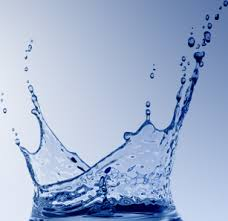







Water in a glass
The water that can be before us on a daily basis that we so often take for granted, and yet quite fascinating and stirring questions. Why doesn’t water just sit flat, why does it sit in little puddles and not go flat and run off the work surface?
Our journey will begin, like so many great explorers before us, in the kitchen. One of our few expectations when we look at water is that the water should lie flat, but water is rarely flat. Look very closely at a glass of water and you will notice how the surface of the water in the glass is not flat, it curves up slightly at the edges: it has a 'meniscus'. This meniscus curve is caused by the water being attracted to the glass, it is being pulled by the glass and then sticking to the edges. The attraction between the water and the glass turns what would otherwise be a flat surface into the gentlest of bowls with a tiny rim.
(Tristan Gooley – How to Read Water)
The Joys of being out by water
This seemed such a delightful piece that it had to have a place here. It is not only about water but what you find in it and around it. So often water helps create an environment that is just so beautiful that it can leave us breathless.
When all else failed, I took myself off fishing. Reading back through my diaries I find page after page filled with accounts of days spent on the riverbank. My trout-
I confess to enjoying fishing. The truth is that fly fishing requires no patience at all. It is essentially about trying to insert yourself into an environment where you don't belong, without being noticed. If you blunder about you won't catch anything -
(Jeremy Paxman -
The Attraction of Water
I wonder if this person’s experience finds an echo in you; it did in mine. If you live in a town then perhaps you have never had the joy of sitting or standing beside an inland expanse of water (or even a small pond at home) and catching the wonder of the movement and light of this stuff we call water that can be so magical. The things we take for granted!
There is a long list of gardening jobs that I loathe; maintaining our pond, however, remains a joy. There are always a few things to be done on any given weekend: brushing, netting, skimming, cutting back the water plants, tackling over-
Last year I was heading out to meet someone when I paused at the pond's edge and looked in, as I invariably do, even when running late for things. Then I tried to leave the scene – as a policeman would put it. But I couldn't. The usual magnetism I feel for water was even stronger than normal. Glancing at my watch, the small sensible part of my brain nagged the larger, irreverent part to move on, but there was something in the water that would not let me go.
(Tristan Gooley – How to Read Water)
The Oceans of the World
This is just a factual piece from a rather old Atlas, but nevertheless it makes us think big in respect of water to those enormous depths that most of us will only ever see courtesy of the deep-
Our world is awash with water. No other planet, as far as we know, has anything like a sea, but seven-
Coursing through these layers, are fast currents, some of them hundreds of miles long and up to 100 miles wide., These currents not only affect the position of fishing grounds but may also influence the world's climate, for a change in the direction of a current can alter the weather far inland.
The sea bed is not merely land covered by water. It is made of rock far heavier than the mixture of comparatively light materials that constitutes most of the land surface. It is the thinnest part of the Earth's Crust and was probably formed at a different time and by a different process than the land, though how and when are not known.
It was once thought that the sea’s bottom was flat and featureless, but intensive research and exploration have begun to reveal something of its grotesquely-
(Readers Digest Atlas)
Rainfall
Just a bit of factual information, again about this planet we live on. On a grey wet day we perhaps might think that a land with no rain would be good -
Record Weather: Driest
The driest place in the world is famously the Atacama Desert in Chile where there ls more or less no rainfall at all. A few times a century there is a passing shower, bumping up the annual average to a fraction of an inch, but decades pass without a drop falling.
Record Weather: Wettest
The highest annual rainfall is in Mawsynram in India, where some 467in (11,862mm) of rain have been recorded. The most rain in one day was on the island of La Renunion in the Indian Ocean on 16 March 1952: 70in (1,778mm). On Guadeloupe on 26 November 1970, 1 1/2in (38mm) fell in a single minute.
Precipitation
Now this is fun information which will make me take a little more note what the wet stuff is that is falling outside!
Precipitation is, if you'll pardon the pun, an umbrella term for water that falls to earth in whatever form. There are a surprising number of different types including:
Drizzle — strictly speaking, raindrops smaller than about 1/50 inch (0.5mm) are drizzle.
Freezing rain, freezing drizzle — rain or drizzle that freezes when it hits a solid object, leaving a layer of glaze ice.
Hail — defined as solid balls of ice between 1/5 inch and (believe it or not) 6 inches (5-
Ice pellets, small hail — small translucent balls of ice, smaller than hail.
Sleet — in the UK, sleet refers to snow that melts as it falls, i.e. rain and snow mixed; however, in US parlance, it normally means ice pellets.
Snow pellets, soft hail, graupel — formed when super-
Snow grains, granular snow — very small (under 1/25inch / 1mm) grains of ice, like small solid drizzle, but falling in small quantities from stratus clouds or fog rather than a shower from a convective cloud.
Thundersnow — snow rather than rain falling during a thunderstorm.
(Both of the above from Campbell’s Weather Compendium)
